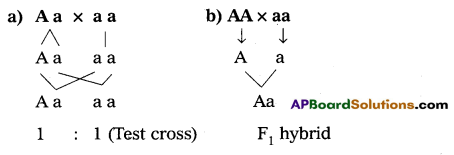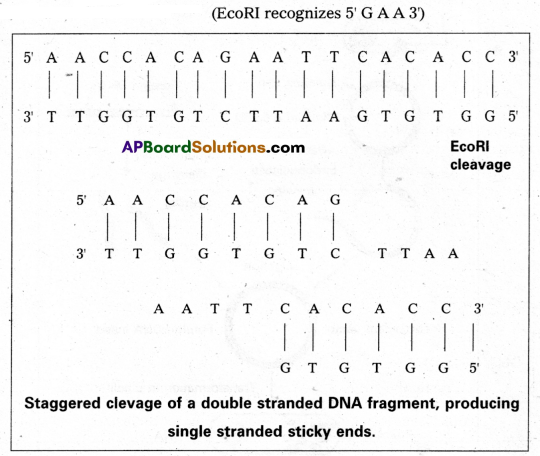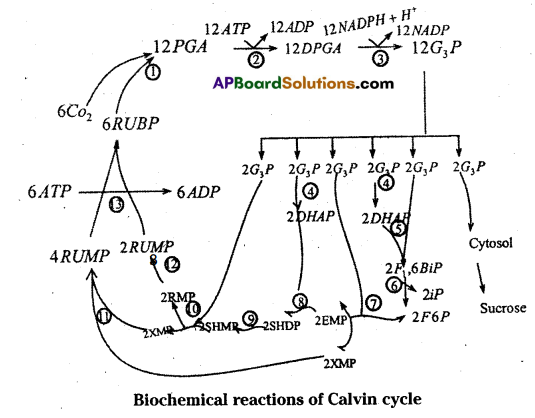Thoroughly analyzing TS Inter 2nd Year Botany Model Papers and TS Inter 2nd Year Botany Question Paper March 2016 helps students identify their strengths and weaknesses.
TS Inter 2nd Year Botany Question Paper March 2016
Time: 3 Hours
Max. Marks: 60
Note: Read the following instructions carefully:
- Answer all questions of Section – A. Answer any six questions out of eight in Section – B and answer any two questions out of three in Section – C.
- In Section – A. questions from Si. Nos. 1 to 10 are of “Very Short Answer Type”. Each question carries two marks. Every answer may be limited to 5 lÍnes. Answer all these questions at one place in the same order.
- In Section – B, questions from Si. Nos. 11 to 18 are of “Short Answer Type”. Each question carries four marks. Every answer may be limited to 20 lines.
- In Section – C, questions from Si. Nos. 19 to 21 are of “Long Answer Type’. Each question carries eight marks. Every answer may be limited to 60 lines.
- Draw labelled diagrams wherever necessary for questions in Sections – B and C
Section – A
10 x 2 = 20
Note: Answer all questions. Each answer may be limited to 5 lines.
Question 1.
Compare the imbibing capacities of pea and wheat seeds.
Answer:
Proteins have more imbibing capacities than starch, so proteinaceous pea seeds show more Imbibition than starchy wheat seeds.
Question 2.
What is lysozyme? What is its function?
Answer:
Lysozyme is a viral enzyme, which dissolve or lyses the cell wall of bacteria, to release their newly produced phage particles or virions.
Question 3.
What will be the phenotypic ratio in the offsprings obtained from the following crisses. (Note: Gene ‘A’ is dominant over gene ‘a)
a) Aaxaa
b) AAxaa
Answer:

Question 4.
In a typical DNA molecule, the proportion of thymine is 30% of the N bases. Find out the percentages of other N bases.
Answer:
A=T, G ≡ C
30 = 30 20 ≡ 20
So Adenine
(A) = 30%,
Guanine (G) = 20%,
Cytosine (C) = 20%
![]()
Question 5.
What is meant by capping and tailing?
Answer:
Adding of unusual nucleotide to the 5’ end of the hnRNA is called capping. Adding of adenylate residues at the 3 end in a template-independent manner is called tailing.
Question 6.
Give different types of cry genes and pests which are controlled by the proteins encoded by the genes.
Answer:
The proteins encoded by the genes cryIAc and cryIIAb control the cotton ball worms, while that of cryIAb controls the corn borer.
Question 7.
What is downstream processing?
Answer:
Separation and purification of products before they are ready for marketing is called downstream processing.
Question 8.
Which part of the plant is best suited for making virus-free plants and why?
Answer:
Apical meristems are best suited for making virus-free plants. Although the plant is infected with a virus, the meristem is free of virus; hence meristems are used to produce virus-free plants.
Question 9.
Name a microbe used for statin production. How do statins lower blood cholesterol level?
Answer:
Monascus purpureus Statins act by competitively inhibiting the enzyme responsible for the synthesis of cholesterol.
Question 10.
Write the balanced equation of nitrogen fixation.
Answer:
N2 + 8H+ + 8e– + 16 ATP = 2 NH3 + H2 + 16 ADP + 16 pi
Section – B
6 x 4 = 24
Note: Answer any six questions. Each answer may be limited to 20 lines.
Question 11.
Explain the steps involved in the formation of root nodule.
Answer:
- Roots of legumes release sugars, amino acids which attracts Rhizobium bacteria. They get attached to epidermal and root hair cells of the host.
- The root hairs curl and the bacteria invade the root hair.
- An infection thread is produced, carrying the bacteria into the cortex of the root.
- The bacteria released from the thread stimulate the host cells to divide, leads to the differentiation of nitrogen fixing cells.
- The nodule thus formed establishes a direct vascu1ar connection with the host for exchange of nutrients.
For diagram:

Development of root nodules in soybean :
- Rhizobium bacteria contact a susceptible root hair and divide near it.
- Successful infection of the root hair causes it to curl.
- Infected thread carries the bacteria to the inner cortex. The bacteria get modified into rod-shaped bacteroids and cause inner cortical and pericycle cells to divide. Division and growth of cortical and pericycle cells lead to nodule formation.
- A mature nodule is complete with vascular tissues continuous with those of the root.
![]()
Question 12.
Transpiration is a necessary evil”. Explain.
Answer:
- It creates a transpiration pull for absorption and transportation in plants.
- It supplies water for photosynthesis.
- It transports minerals from the soil to all parts of the plant.
- It cools the leaf surface.
- It keeps the cells in turgid and maintains the shape and structure of the plants.
- Excessive transpiration makes the cells flaccid, which retards growth and leads to the closure of stomata thus obstructing gaseous exchange. Due to these effects, Curtis regarded ‘Transpiration is a necessary evil’.
Question 13.
Define RQ. Write a short note on RQ.
Answer:
The Respiratory Quotient is defined as the ratio of volume of CO2 evolved to the volume of O2 consumed during respiration. RQ value depends on the type of respiratory substrate. When carbohydrates are in as respiratory substrates, the volume of CO2 evolved is equal to the volume of 02 consumed. So the RQ value is one.
C6H12O6+6O2+6H2O → 6CO2+ 12H2O + 686 K.cal.
RQ = \(\frac{6 \mathrm{CO}_2}{6 \mathrm{O}_2}=\frac{6}{6} \) = 1
When fats are in as respiratory substrates, the volume of CO2 evolved in less than the volume of O2 consumed. So the RQ value is less than one.
2(C51H98O6) + 145O2 → 102 CO2 + 98 H2O + energy
RQ = \(\frac{102}{145} \) = 0.7
When proteins are in as respiratory substrates, the RQ value is 0.9.
Question 14.
How auxins are applied in agriculture/horticulture?
Answer:
- IAA, IBA, and NAA help to initiate roots in stem cuttings. It is widely used in horticulture.
- 2, 4 – D, 2, 4, 5 – T acts as herbicides which kills abroad leaved dicot weeds.
- Auxins stimulate fruit growth in Tomato.
- Auxins induce, flowering in pineapple.
- Auxins prevents preharvest fruit drop.
- Auxins favour the formation of female flowers in Cucurbita.
Question 15.
How are bacteria classified on the basis of number and distribution of flagella?
Answer:
Bacteria are classified into four types based on the number and arrangement of flagella.
They are
- Monotrichous: A single polar flagellum is present at one end of Bacterial cell.
- Lophotrichous: A tuft of flagella at one pole of the cell.
- Amphitrichous: A single flagellum at each end of the cell.
- Peritrichous: Flagella distributed over the entire cell.

![]()
Question 16.
Define and design a test cross.
Answer:
Cross between F1 hybrid and recessive parent is called test cross. A monohybrid test cross gives a phenotypic ratio of 1: 1 and a dihybrid test cross gives a ratio of 1: 1: 1: 1.

Question 17.
Draw the schematic/diagrammatic presentation of the lac operon.
Answer:

Question 18.
What are bio-safety issues concerned with genetically modified crops?
Answer:
- There is fear of transfering allergins or toxins to Humans and animals as side effect.
- There is a risk of changing the fundamental nature of vegetables.
- They may pose a harmful effect on biodiversity and have an adverse effect on environment.
- There is a risk of gene pollution due to transfer of new genes into related wild species through natural outcrossing. This may results in the development of super weeds which may be fast growing than the crops and may be resistant to weedicides.
- They may bring about changes in natural evolutionary pattern.
Section – C
2 X 8 = 16
Note: Answer any two questions. Each answer may be limited to 60 lines.
Question 19.
Explain briefly, the various processes of recombinant DNA technology.
Answer:
The important method in. recombinant DNA technology are performed through genetic engineering.
They are:
- Isolation of a desired gene
- Insertion of isolated gene into a suitable vector
- Introduction of recombinant vector into a host and
- Selection of the transformed host cells.
E – The first letter, represents the name of genus Escherichia.
Co – The next two letters, represent the species Escherichia Cou.
The letter R is derived from the name of strain.
Roman numbers following the names indicate the order in which the enzymes were isolated from the strain of bacteria.
This enzyme specifically recognises GAA sites on the DNA and cuts it between G and A (G ↓A)

The resultant fragments are separated from each other by gel electrophoresis.
The desired fragments are selected by Southern blotting technique.
II) Insertion of isolated gene into a suitable vector:
- The selected fragments of DNA are inserted into a suitable vector to produce a large number of copies of genes.
- This is called gene cloning.
- There are two major types of vectors, namely plasmids and bacteriophages.
- Among the two types, plasmids are the ideal cloning vectors.
- To isolate a plasmid, the Bacterial cell is treated with EDTA (Ethylene diamine tetra acetic acid) along with lysozyme enzyme to digest the cell wall.

- Then the bacterial cell is subjected to centrifugation in sodium lauryl sulphate to separate the plasmid.
- The plasmid DNA is Cut with the help of restriction endonuclease.
- The circular plasmid is converted into a linear molecule having sticky ends.
- The two sticky ends of linear plasmid are joined to the ends of desired gene by DNA ligase.
- The plasmid containing foreign DNA segments is called recombinant DNA (r DNA) or Chimeric DNA.
III) Introduction of recombinant vector into a suitable host:
- The rDNA molecule is introduced into suitable bacterial host cell by transformation.
- The cell containing r DNA is called transformed cell.
- Bacterial cell walls are not permeable to recombinant vectors, but keeping in dii. Calcium chloride renders the bacterial cell wall permeable to recombinant vectors.
- The rDNA replicates within the host cell
- The transformed cell grows on the culture medium. Each daughter cell contains r DNA.
IV) Selection of transformed host cells:
- The selection of transformed cells depends on the nature of gene which is cloned.
- It can be done in two ways.
They are:
a) Without using probes
b) By using probes.
a) Without using probes:
- If the gene is cloned for antibiotic resistance, the cells are first incubated on a medium without antibiotic for one hour, to allow the antibiotic resistance gene to be expressed.
- Then the cells are placed on a medium with an antibiotic for selection of colonies containing rDNA.
- The cells which have expressed the gene will survive and the others die.
b) By using probes:
- When transformed cells are cultured on the nutrient medium, several cells are produced.
- To select the cells containing the desired gene colony hybridization method is used.
- In this gene specific probes are used. A probe is a small fragment of single-stranded RNA or DNA which is tagged with radioactive, molecules. It can search out complimentary DNA sequences from an organism.
![]()
Question 20.
You are a Botanist working in the area of plant breeding. Describe the various steps that you will undertake to release a new variety.
Answer:
The main steps in breeding a new genetic variety of a crop are:
1. Collection of Variability: Genetic variability is the root of any breeding programme. Collection and preservation of all the different wild varieties, species, and relatives of cultivated species is a prerequisite for effective exploitation of natural genes available in the populations. The entire collection having all the diverse alleles for all genes in a given crop is called the Germplasm collection.
2. Evaluation and selection of parents: The germplasm is evaluated so as to identify plants with desirable characteristics. The selected plants are multiplied and are used. Purelines are created wherever desirable.
3) Cross Hybridisation among the selected parents: After emasculation (Removal of Anthers from the bisexual flower of a female parent) the female flowers are enclosed in a polythene bag to prevent undesired cross-pollination. Pollen grains are collected from the male parent with the help of a brush and are transferred to the surface of the stigma and thus cross pollination is affected artificially.
4) Selection and Testing of superior recombinants: It involves selecting among the progeny of hybrids, those plants that
have the desired character combination. The selection process requires careful scientific evaluation of the progeny. Due to this, plants that are superior to both the parents are obtained. These are self-pollinated for several generations till they reach a homozygosity.
5) Testing, release, and commercialization of new characters: The newly selected lines are evaluated for their yield
and other traits of quality, disease resistance, etc. It is done by growing these in research fields and recording their performance under ideal fertilizer application, irrigation, and other crop management practices. It is followed by testing the materials in farmers’ fields for at least 3 growing seasons at several places in the country, in all agroclimatic zones. Finally, they are distributed to farmers as a new variety.
Question 21.
Explain Calvin cycle with the help of equations.
Answer:
Melvin Calvin, Andrew Benson, and James Basham discovered this pathway in chlorella and hence named as Calvin cycle. It is also called the Photosynthetic Carbon Reduction cycle [PCR cycle] or reductive pentose phosphate pathway.
The Calvin cycle can be described in three stages:
- Carboxylation
- Reduction and
- Regeneration.
1. Carboxylation: In this, six CO2 molecules reacts with six molecules of RUBP to form 12 molecules of PGA in the presence of water and RUBISCO, an enzyme
6CO2 + 6RUBP + 6H2O → 12 PGA
2) Reduction:
1. 12 molecules of PGA are phosphorylated to 12 molecules of DPGA in the presence of phosphogly cerokinase.
12PGA+12ATP →I2DPGA+12ADP
2. 12 DPGA molecules are reduced to 12 G:P molecules in the presence of G3P dehydrogenase.
12 DPGA + 12 NADPH + H+ 12 G3P + 12NADP + 12H2PO4–
3. Regeneration: Of 12 G3P molecules, 2G3P molecules are transported from chloroplast to cytosol. Here, they are utilised In the synthesis of hexose and then sucrose. The remaining 10 G3P are utilised to regenerate RUBP molecules.
4. Of 10 G3P molecules, 4 are isomerized to 4 DHAP (Dihydroxy acetone phosphate) ¡n the presence of Isomerase.
4G3P →f 4DHAP
5. 2 molecules of G3P condense with 2 DRAP molecules to form fructose 1, 6 Biphosphate in the presence of aldolase.
2G3P + 2DHAP → 2F1, 6BiP
6. 2 molecules of F1, 6Bip undergoes dephosphorylation to form F6P in the presence of phosphotase.
2F16Bip → 2F6P + 2iP
7. 2 molecules of F6P combines with 2 molecules of G3P to form two molecules of Erythrose 4 phosphate and 2 molecules of xylulose-5-phosphate in the presence of transketolase.
2F6P + 2G3P → 2XMP + 2EMP
8. Two molecules of EMP combines with 2DHAP to form 2 molecules of SHDP (Sedoheptulose -1, 7 biphosphate) in the
presence of aldolase.
2 EMP + 2DHAP → 2 SHDP
9. Two SHDP molecules undergoes dephosphorylation to 2SHMP in the presence of phosphatase inorganic phosphate is released.
2SHDP → 2SHMP + 2iP
10. 2SHMP molecules combines with 2G3P to form 2 molecules of ribose monophosphate (RMP) and 2 molecules of XMP in the presence of transketolase.
2SHMP + 2G3P → 2RMP + 2XMP
11. 4 molecules of XMP (7, 10) are epimerised to form 4 molecules of RUMP in the presence of epimerase.
4XMP → 4RUMP
12. 2 RMP molecules are isomerised to 2 RUMP molecules in the presence of Isomerase
2RMP → 2RUMP
13. 6 RUMP molecules are phosphorylated to form 6 RUBP molecules in the presence of kinase.
16RUMP+6ATP → 6RUBP+6ADP
![]()
The overall equation is
6CO2 + 6RUBP + 6H2O + 18ATP + 12 NADPH + H+ → Glucose + 6 RUBP + 18 ADP + 12 NADP
Hence for every CO2 molecules entering into the Calvin cycle, 3 ATP and 2 NADPH are required.

Enzymes are:
- RUBISCO
- Phosphoglycerokinase
- G3P dehydrogenase
- Triosephosphate Isomerase
- Aldolase
- Fructose 1, 6 Biphosphotase
- Transketolase
- Aldolase
- Sedoheptulose – 1,7 biphosphotase
- Transketolase
- Epimerase
- Ribose 5 Phosphate Isomerase
- Ribu lose -5 – phosphokinase